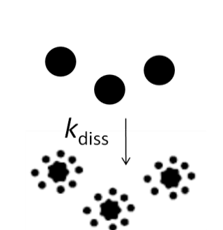Dissolution Rate Constant
The dissolution rate constant is the proportionality constant quantifying the dissolution rate of a material. The dissolution rate proceeds through several coupled processes, including transport of solutes between the bulk material and the background solution, the ad- and desorption of solutes at the bulk material’s surface, hydration and dehydration of ions and surface migration. All those processes have to occur simultaneously, but some may be slower than others. Since the overall dissolution rate depends on the rate of the slowest process, it is important to identify the rate limiting mechanism (Appelo and Postma, 2005).
 |
Used for |
Algorithms |
|
\(\frac{d[M^{z+}]}{dt} = k_{diss}([M^{z}]_{eq}-[M^{z+}]_{t})\)
Dissolution rate
Read more |
Read also |
|
Consult the NanoFASE Library to see abstracts of these deliverable reports: NanoFASE Report D8.2 Driving Forces of NM Behaviour in Natural Waters for Agglomeration and Transformation |
Appelo, C., Postma, D. (Ed.), Appelo, C. (Ed.), Postma, D. (Ed.). (2005). Geochemistry, Groundwater and Pollution, Second Edition. London: CRC Press |
Contact
 Frank von der Kammer
Frank von der Kammer
University of Vienna, Austria
Email: frank.von.der.kammer@univie.ac.at

